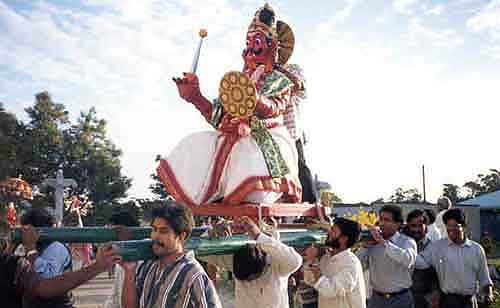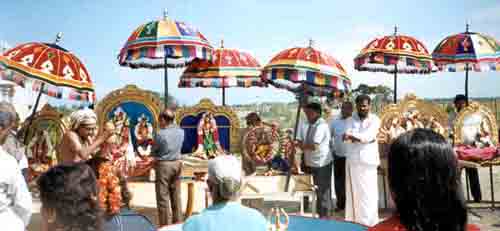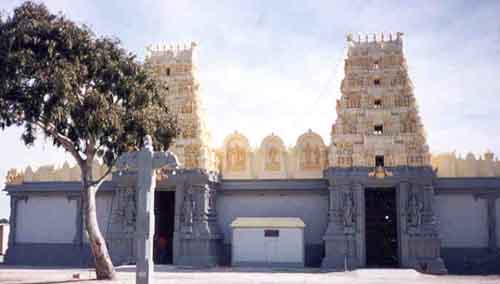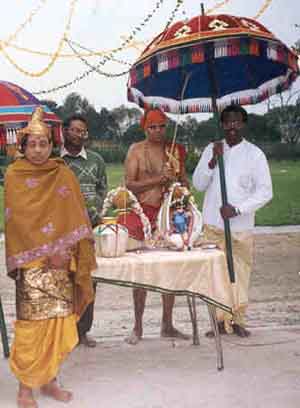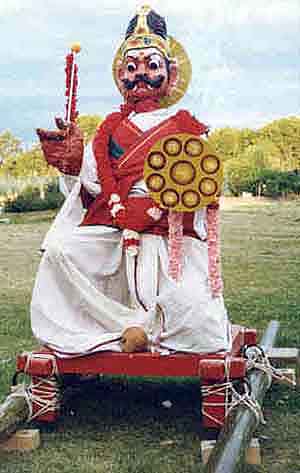
|
||||||||||
|
| ||||||||||
Murukan Worship in MelbourneSivasupramaniam SitsabesanPrologue
Globetrotting has been a phenomenon of Tamils; they are one of the seafaring races since time immemorial. Yet, the landscape of Tamil race endured a drastic variation with the advent of European colonization and/or as an after effect of such colonization and so began an era of migrations. Tamils began to make homes outside their traditional homeland, not necessarily by choice but by a combination of circumstantial factors such as political, economical and social. "Do not live in a place where there is no temple" is a Tamil maxim and true to that spirit they built temples wherever they settled.Today there are Hindu temples across the globe. According to Encyclopedia Britannica, "Tamil race is perhaps the greatest temple builders in the world". Temple is perceived as a way of engaging the energies and talents of the community to allow its members to evolve to a higher state of perfection. Murukan characterizes youth, splendor and beauty and many other things that normally associated with goodness. Like all different sects of Hinduism, Murukan faith is also undergoing the process of relocation and adaptation across the globe. The fact that the Murukan faith accommodates a range of beliefs and practices inspires tenuous concept of identity. Nevertheless, the same phenomena serve to facilitate participation of a wide spectrum of the society. Murukan symbolises the time cycle and represents the cosmic process of creation and dissolution, day and night, life and death. Murukan worship is vast and this article is by no means exhaustive but persuasive enough to leave a lasting impression on one's mind and to encourage further researches. BackgroundAustralia's multicultural society recognizes the diversity of its people and nurtures the aspirations, beliefs, traditions, and practices of individuals. Melbourne is the capital of the state of Victoria and according to the 1996 census 6,251 Tamils live there, second only to Sydney's 9,072. Australia's Tamil population is 18,690. There are Saiva temples in all states and territories except in the state of Tasmania, which has a small population of Tamils (76 according to 1996 census). According to recent estimates Tamil population in Australia has reached 30,000 and continue to grow rather rapidly. Murukan worshipers in Australia are predominantly Tamil speaking people and most of them are of Ceylonese, Indian, Malaysian, Singaporean, Mauritius and Fijian origin. Tamils have a short history of about quarter of a century in a land where the white settlers have a two hundred-year history. Murukan is considered as a Dravidian and/or Tamil god and though some of the beliefs, traditions, practices of the Aborigines could remotely be linked to Dravidian group of people, yet there is no definitive research to confirm it. Therefore, the origins of Murukan worship could only be linked with immigration of Tamil speaking people to Australia in the mid 1970s. The estimated Tamil population in Australia prior to the mid 1980s was in the region of 3,000 to 3,500 and organized form of religious activities began only after the mid 1980s when the influx of Tamil immigrants began in large numbers. Religious activities began in the form of congregational prayers and temples were built subsequently. Murukan temples are located in Melbourne (in the state of Victoria), Sydney (in the state of New South Wales), Perth (in the state of Western Australia) and Canberra (Australian Capital Territory). TemplesPrelude:Temples are the sole forum for the articulation and continued negotiation of Hindu identity in Australian society.Temple serves as an epicenter of cultural activities. Temples are the cornerstones of not just Murukan worship but of the greater Saivism. There are three temples in Melbourne; permanent structures are built observing agamic principles while factoring the local socio-environmental-statutory circumstances. Lord Murukan with his consorts Teyvanai and Valli is the presiding deity at Melbourne Murukan temple and it is only one of its kinds in Melbourne. Other two are Siva-Vishnu temple at Currum Downs and Śrī Vakratunda Vinayakar temple at The Basin. Śrī Vakratunda Vinayakar Temple is located at The Basin, about 35 km east of City, a place in the midst of areas of natural scenic beauty. This temple was consecrated in October 1992.The presiding deity is Śrī Vakratunda Vinayakar. Idols of Murukan with his consorts Teyvanai and Valli, Durga, Abhirami and Navagraham are enshrined in the inner courtyard along with statues of Nataraja with his consort Parvati, Murukan with his consorts Teyvanai and Valli and Visnu. Melbourne Vinayakar Hindu Sangam manages this temple and has plans for further expansion. This temple publishes a newsletter and runs a weekly two-hour Hindu religious radio program, both in English and Tamil, to develop a better understanding of Hinduism amongst the non-believers and to serve as an informative as well as educative opportunity among the believers.
Siva Vishnu TempleSiva Vishnu Temple is situated at Carrum Downs, a place located in the South-east of City in close proximity to sea. This temple was consecrated in May 1994. This temple reflects the growing convergence of two of the main streams in Hinduism: Saivism and Vaisnavism. There are two temples under one roof: one half of the temple dedicated to deities of Saivism and the other half dedicated to the deities of Vaisnavism with two areas symbolically connected by a shrine of Hariharan (Aiyyapan) located along the notional dividing line. This temple is built on enormous extent of land and the temple has two processional paths. There are two temple towers, both filled with sculptures depicting stories from Hindu epics and those scriptures inspiring the beholder in divine contemplation. These representations being the infinite expressions of infinite beauty of god through the medium of infinite materials such as stone, metal etc., which is one of the basic characteristics of Hinduism. This temple is also claimed to be one of the biggest in the southern hemisphere with 1500 square meters of roofed area with 39 deities enshrined there. Hindu Society of Victoria manages this temple. This temple too has plans to expand. This temple has a vast stretch of land in its possession in a secluded area and would possibly become a religio-cultural center in future.This temple publishes a newsletter too. Melbourne Murukan TempleMelbourne Murukan Temple at Sunshine is located in the western suburbs of Melbourne. This center is the fruit of ardent devotees of Murukan who so desired to build a dedicated temple for their beloved god. The center was formed in 1995, the temple project was launched and the first stage of the temple was completed in January 1999. Currently the statues of Lord Murukan with Teyvanai and Valli and Vinayakar are held in a hall where a resident priest conducts puja and abishekam. Idols of Navagraham are enshrined too. Melbourne Murukan Cultural Center manages this temple and endeavors to build a fully-fledged traditional style temple in the near future. This center attracts devotees from far and wide.
FestivalsIntroduction: Murukan is correlated with sun, moon and rain; accordingly he presided over the coming of the rains and blossoming of trees etc. The Paripatal refers to the coming of the monsoon, the concomitant flooding and fecundation of the earth as the arrival of Murukan with his entourage of elephants and army.Lunar cycle plays a vital role in the eastern religions; in Murukan faith three stages in the fortnight between waxing and waning moons have significances attached to them. The first tithi of the new moon is known as the day of Murukan's birth, second tithi is Sasti and the third tithi being the full moon. Full moon stands for completion, fulfilment and total maturity and is the pinnacle of the cosmic cycle and the maturity of the deity. Most of the important dates in the religious calendar are observed in these temples and it goes without saying that monthly Karttikai and Sasti, annual Kanta Sasti, Vaikaci Vicakam, Taippucam, Pankuni Uttiram are observed with special rituals. It is just that the proceedings vary from one temple to the other; it would just be performing of abhishekam (holy bath) and puja in one temple while in another temple the deities are then taken in procession in the inner and outer courtyard. The festivals in Melbourne temples are held according to traditional style with minor variations to suit the local conditions. Karttikai is celebrated each month and is of particular significance as it commemorates the coming into being of Kantan and his being nurtured into maturity and his lordship over time. Karttikai is equivalent of 'birthday'. After the abhishekam and special puja, utsava murti or bronze icon of Murukan is taken in a procession in the inner courtyard of the temple. Karttikai is observed in all the three temples as a monthly special puja. During the Tamil month of Karttikai, the Karttikai natchatiram is celebrated as Tiru Karttikai and the custom of lighting lamps outside homes and temples are followed here. Kanta Sasti:The sixth day of the waxing moon in the month of October-November is celebrated as Kanta Sasti. Sasti is associated with the destruction of evil forces, asuras (demons). Murukan engaged the armies of Singhamukhan, Surapadman and Tarakasuran on a six-day battle and vanquished all of them on the sixth day. Events leading to the conquest of the asuras are dramatized and enacted.Murukan's triumph over the cosmic forces of evil is celebrated. The asuras were annihilated and the gods were liberated. This battle is known as Surasamharam. This is one of the important Murukan festivals in all the three temples in Melbourne. During the Kanta Sasti period, daily abhishekam and special puja are conducted each day. Surasamharam is held as a vibrant ceremony on the sixth day. Siva-Vishnu temple and Sri Vakratunda Vinayakar temple has huge structures depicting the evil forces and the ceremony is conducted in the traditional style with puppet demon changing many masks. Corresponding to the six days of the war over the evil forces, devotees undertake fasts, prayers and devotional singing to Lord Murukan. An increasing number of devotees are fasting here; they consume fruits and/or milk once a day for the six days and complete their fast on the seventh day before sunrise. Vaikaci Vicakam: Vicakam that occurs during the Tamil month of Vaikaci is the commemoration of Murukan's birth and ascendancy to a place of supremacy amongst the gods. This is observed with abhishekam and special puja here. Taippucam: Poosa natchatiram during the month of Thai is observed as Taippucam. It was on this day that Murukan was given his Vel by his mother Parvati, at the outset of his campaign to defeat Surapadman, head of the asuras. Devotees undertake kavadi and patkudam (milk pot) on the Taippucam day. Kavadi is increasingly becoming an important feature of Taippucam festival. Kavadi refers to a horizontal pole held on the shoulder on two ends of which load is carried and it assumes the form of human body; the wooden structure represents the bones; the cloth cover represents the skin; the string woven around it represent the veins and the milk contained in the two pots hung by the two ends is the blood. Therefore the act of lifting a Kavadi is professed as submitting oneself at the feet of Murukan himself. At the end of the Kavadi procession, abhishekam is held to Lord Murukan at the sanctum sanctorum. A devotee who carries kavadi or patkudam aspires to view the milk being poured on Lord Murukan inside the shrine where he or she reaches after an arduous journey. In Melbourne, the Kavadi festival has not reached the magnanimity as in Singapore, Malaysia, Mauritius, Seychelles etc., but still remains an important festival in the Murukan calendar. Pankuni Uttiram: Pankuni Uttiram in March-April is celebrated as the wedding of Murukan. His wedding and the concept of marriage are subject to intense research. Teyvanai and Valli, consorts of Murukan, represent two types of love, Teyvanai symbolise karpu or chastity (an orthodox form of marriage) while Valli characterise kalavu or love outside of marriage. In northern hemisphere, the climatic day of Pankuni Uttiram is said to mark winter's becoming summer and cold's turning hot, opposite happens in southern hemisphere. Not withstanding this fact, the Pankuni Uttiram is still a special day amongst Murukan worshipers in Melbourne. ConclusionThis study facilitates to conclude that the Hinduism in general and Murukan worship in particular are popular in Melbourne. Congregational centres were formed; devotees assembled there for weekly prayers and special occasions; idea of constructing temples got rooted. Temples were built within a short span of two decades. Lord Murukan is enshrined in all the temples and it is a clear demonstration of the popularity of Murukan worship. The observance of Murukan calendar and the congregation on such special occasions at temples do characterise the popularity of Murukan worship in Melbourne. References
"Murukan worship in Australia" by Dr Arumugam Kandiah
|
